And you should invest in my company to create it.
Between Facebook, Twitter, LinkedIn, and whatever new thing is invented between now and the time I publish this blog post, the universe of social media is vast and ever-expanding. It’s easy to feel overwhelmed by the amount of information and the newness of the technologies conveying and producing it.
But social media needs a new tool that recognizes how powerful images are, and someone should give me a million dollars to keep investing in creating it.
Or rather, I should practice asking here so that when I actually ask in the right venue—Kickstarter? Crowdfunder? A company that links investors and companies, like Seed Equity?—it’s a proper pitch.
Proper pitches have three elements: the story, the service, and the scratch.
Ironically for a story-teller, the story is the hardest part of this for me to put together. I’d really rather sit down with you and have tea. But being able to present the story professionally is also the most important element of all. For instance, for Kickstarter, you have to write a proper script to make a proper video to make a proper pitch. Story is a necessary but not sufficient condition of all proper pitches. So here goes story.
Story
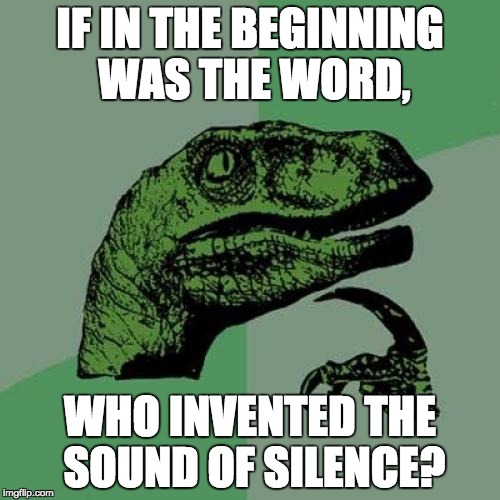
I left a Post-Doctoral Fellowship at Harvard to start my own business as an artist. Like many bold decisions, it seemed over-determined to me at the time—like I couldn’t do anything else, so why even try to figure out why it was the next step or what came next? I am going to speak and help other people speak truth to power while drawing more selective attention to positive stuff instead of counting up abuse cases, because that’s what will really make vulnerable people safer.
This decision seemed totally crazy to everyone around me. Especially to the very few people to whom I said at the same time—I want to make world peace through art. And the one person to whom I said—I want to defeat ISIS. And the nobody but God to whom I said—why doesn’t everybody understand with flashes of light and insight how the information environment is where security comes from, because the story we tell about reality shapes it, and that’s why You started out with the word? (Christianity shares this belief—about the sanctity of the word—among many others with Islam.)
In my job as the post-doctoral researcher on the Justice Database, the first national database of police behavior, I traveled around the country pitching Database participation to police departments. The essence of my pitch was that other professional fields, like medicine, have national comparative datasets that let them help each other discover how to make best practices better. In addressing the concern that the data might be used to “name and shame”—like media reporting on racial disparities and police use of force often is—I cited Carol Dweck’s work on mindsets. Dweck shows a “growth” orientation of learning and helping learn, as opposed to a “fixed” orientation of judging and being judged, correlates with success across a wide range of contexts—educational, professional, and personal. The Database project has a “growth” mindset orientation, and that’s one reason why participation in it is confidential unless departments self-disclose it.
This work brought me to the biggest law enforcement leadership conference in the nation, where I had something of a religious experience involving singing policemen. I also heard Representative Dutch Ruppersberger III (D-MD) of the House Appropriations Committee and Secretary of Homeland Security Jeh C. Johnson talk about ISIS/ISIL and the problem of homegrown violent extremists, who seem to sometimes be radicalized on social media.
I also learned to pronounce the word “meme.” (Say: “me-m.”)
Then I stayed up all night making counter-terrorism memes and learned how to use Twitter. I am the least probable person to figure out anything new about social. I’m just beginning to understand how social networks work in real life. I just got a smart phone last April because my job required it, and had texting blocked on the phone number I never gave out anyway before that.
Except. I care like a girl. And my lack of prior expertise in social media made me approach it like I approach all new things I want to learn: like it was mine to make a big mess with until I made something I liked.
Boy, did I make a big mess. I’ve basically always been solvent except for federal student loans from undergraduate. But I went into five-figure credit-card debt doing stuff like paying search engine optimization “experts,” social media managers, and web developers to help me actualize my idea. They didn’t. But I learned from what they did wrong. A lot. Every mistake was like a seminar, and I have no problem paying for education. This stuff is so new that there really is no better way to learn than by doing—and anyway we know more generally that testing before you’re ready and making mistakes is a great way to learn.
So that’s the story. I had published poetry for years, organized a local stand-up comedy group, exhibited and sold art, and otherwise “done art” for about ten years. But I had never before put together how it could interface with my academic credentials and professional experience to be of service.
Service
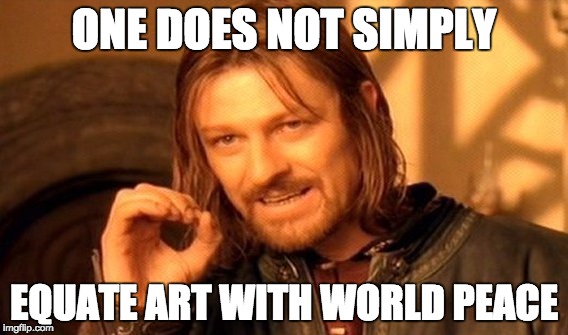
The new social media tool I want to create is going to be of valuable service to society in general and vulnerable groups in particular in four ways.
1. Big-picture service.
Making the world feel safe to flourish through art.
People don’t know what I mean when I say this. I know what I mean when I say this. I’m still working on closing that gap.
2. Correcting for reporting bias.
Drawing selective attention to successes rather than failures, context rather than outliers, positive stories of improvement rather than the negative ones of violence and prejudice that tend to dominate reporting on safety—as exemplified by how we call these sections in newspapers “crime” beats, and reporting on what government forces do abroad is mostly “war” reporting. What’s lost in these characterizations is not just the ambiguity innate to what Tim O’Brien and others have called “true war stories,” but also mindful use of the power of selective attention to generate the outcomes on which we focus. It’s important to use that power wisely in part because it correlates with better outcomes—as in the placebo effect.
And also in part because there are systematic reporting biases that cut the other way. For example, we don’t hear about the vast universe of cases in which ordinary policework does not harm or helps people. Privacy protections rightfully keep us from knowing when police help citizens in mental health crisis or abusive relationships get to safe places. And being busy probably keeps regular people who might be stopped speeding and let go with a warning—who might then drive more safely—from thinking much of the experience. So we’re likely to hear only about the relatively small universe of cases in which something goes horribly wrong in police interactions. That type of reporting bias then hurts public perceptions of police, which in turn hurts community trust.
It’s nobody’s fault. It’s not a plot. The media are not bad. It’s just that all the incentives in reporting are structured so that media attention centers on what goes wrong instead of what goes right. And that has consequences.
One might argue that those consequences include cases like the recent death of a young Boston-area man who “liked” an ISIS-affiliated Facebook page and allegedly plotted to attack police, prompting police to confront him first.
That’s not just a one-off. Procedural justice research shows that trust underpins security. People are more law-abiding and cooperate with police more when they trust that police act fairly. Thus trust makes security while mistrust breeds lawlessness and insecurity. So addressing reporting bias by drawing attention to the broader context and the positives is actually one of the best ways to make vulnerable people safer from prejudice and violence.
Those biases hurt public perceptions of police, which in turn hurts trust in government and actually makes people less safe. This is a national security issue because of associations (psychological and material) between local/state police and federal security forces, despite their separation in the US—as the Boston attacks show.
3. Giving people space to create.
Spaces, actually.
a. Memes. Currently, I envision the tool as a website featuring tabs for repositories of subgroups of memes on five main themes, plus a generator that lets you customize those memes or create your own. This is like the successful Keep Calm Generator model on steroids.
b. Discussion forum. I’m not a big fan of these myself because they’re usually negative—adversarial, unforgiving of mistakes, generally not the ethereal equivalent of sitting down with a friend for a cup of tea. I want to create a positive space, but without micromanaging it. We’ll see how that works with a few simple rules (e.g., this is a respectful space—no hate speech—that means no Mohammed Toons here or in the memes section).
c. News aggregator with cover meme generator. Aggregated news using the Paper.li platform plus a front page aggregator to let you see a bunch of covers at a glance. And has a meme generator too, so you can make your own headlines on the covers.
d. Merchandise creator. No meme generator is complete without a link to creating your own stuff. It’s so easy to make an Etsy or Zazzle store. I did it for my oil paintings on this website. Why not do something like that for memes?
That is not a rhetorical question. I’m not sure if there are legal problems doing this with images I’m using for satire but didn’t create—which is most Internet memes. So for sure I can sell my own merchandise here, but I need to research this question further. Which is one reason why I need more funding, to keep investing in asking experts for help. Even though sometimes the help experts can give you is that you had better figure it out yourself.
4. Gives people a new tool for creating dialogue, too—for reaching out to political opponents. The three main challenges in countering radicalization of young people by groups like ISIS are the echo chamber effect, the decentralized nature of the Internet, and the free speech laws that characterize Western legal regimes.
a. Echo chamber. The echo chamber effect isn’t new to the Internet, but the Internet makes it worse. It’s also sometimes called information Balkinization and is one instantiation of confirmation bias, a common cognitive bias in which we tend to look for information that confirms we’re right. Being right feels good, so we seek out information sources that tell us we’re right. Thus people who agree with Fox News tend to watch Fox News, and people who agree with Rachel Maddow tend to watch Rachel Maddow.
In the context of radicalization, this means that forums where people advocate for ISIS don’t get a lot of traffic from people who might offer alternate narratives. This is a problem because it makes radical views seem normal.
b. Decentralized mess. Moreover, the decentralized nature of the Internet—large, sprawling, and created by many people doing their own thing, together—makes it effectively impossible to surveil. This is why national security agencies want to capture massive amounts of data to trawl through later in directed investigations. It’s simply not possible to keep up with the expanding universe of social media in real time. Even if it were, encryption is making it harder for law enforcement to follow open source communication trails, like emails seasoned terrorists might exchange with recruits after making contact with them on social media.
c. Free speech. Dastardly free speech strikes again!
Even if you could keep up with hate groups on social media, you couldn’t take down most ISIS propaganda. Especially the really good stuff that uses memes, music, art, humor, and literary or Quranic textual allusions. Because we live in a free society. So far from refusing to negotiate with terrorists, have to engage in dialogue with them in the marketplace of ideas that is the Internet.
That dialogue has to be local, and it’s best if it comes directly from the same communities whose members are being radicalized. So this tool needs to use location information from Twitter and Facebook users’ public profiles to match, e.g., ISIS account followers with other folks from similar locations. This way, people who want to reach out to folks in their own communities who are effectively tuned into Radio ISIS online, to offer a different song? It’s easy for them to do. Because it should be easy, and it’s not now.
This is a translation of basic community-oriented policing principles to social media.
I can’t believe no one has already done this.
But I can also see how creating a tool for users to reach out to social media followers of particular groups like ISIS, to decentralize the response to hate groups’ recruitment on social media and encourage political dialogue, might be more controversial than the rest of this project. This kind of tool has obvious abuse potential. It could be used by political parties to run smear campaigns, or hate groups to send threats. And I’ll do what I can to engineer it so that doesn’t happen.
But any communication tool that helps people address particular networks can be abused in a free society. The potential for good outweighs the potential for bad. We know from field experiments on political behavior that people are easily shamed into behaving better next time when you tell their neighbors how they misbehave. All you have to do to increase voting is tell people you’re going to tell their neighbors if they don’t.
So making people who follow ISIS-associated accounts on Twitter or like them on Facebook into neighbors—making it easy for people who are near them to reach out to them for dialogue—ups the emotional ante of the simple Follow or Like act that plugs people into social networks that have sometimes had the apparent effect of encouraging violence. It does this without government surveillance. It does this without using information other than what is already open-source. And it does this in a way that might encourage dialogue before radicalization occurs, potentially saving the lives of crime victims and potential criminals alike.
So that’s the service component. The new social media tool I envision makes the world feel safe to flourish through art by focusing on what is good and how we can do more of that as a society, giving people space to create art and hold dialogue with political opponents in that spirit. There are lots of such spaces already, but none of them makes it really easy to change the narrative coming at people who express support for hate groups on social media.
Scratch
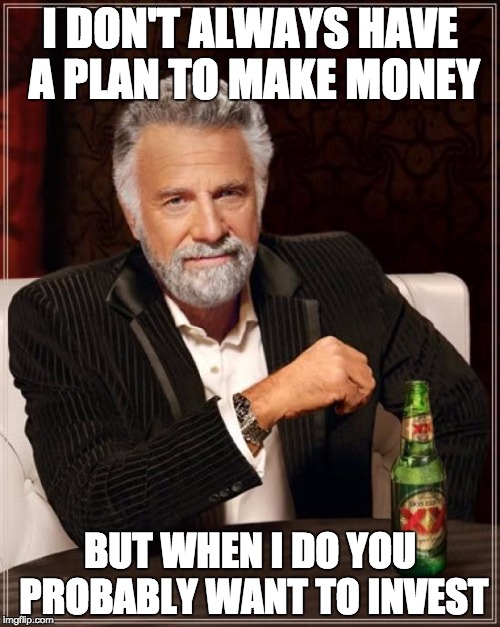
Money is a metaphor for value, and this new social media tool is extremely valuable because it fills an important gap in the information environment, appealing to a mass audience with broader impacts for society at large.
Right now I see it as a website like Facebook or Twitter. The website makes money in the following five ways:
1. Short-term: Donations using Venmo or PayPal.
2. Short-term: Zazzle store (merchandise).
3. Medium-term: Ad and/or product placement revenue.
4. Medium-term: Converting the Zazzle store to other forms of merchandising with better profit margins (but more start-up and maintenance costs). Xkcd followed this step-wise merchandising model.
5. Medium-term: Divine pop-up art kit on Etsy. Just an idea at this point, for putting together the tools to let people make their own “art in place” more easily. Probably another one of those things that I know what I mean, but not yet how to show and tell other people what I mean.
Basta
Enough. That’s it. That’s the first draft of the proper pitch for one of four elements of my art business. And it only took me four months to get clear enough on in my unspoken language to draft!
To be fair, this is a draft proposal for revolutionizing counter-terrorism by creating a new tool that brings community-oriented policing into the information age. It has to be done from the private sector because we live in a free society where the government doesn’t run the media. And it has to be done by an artist with some science and politics chops—maybe a history of earning National Science Foundation Political Science funding—and maybe some expertise in policing. WHERE WILL YOU EVER FIND SUCH A PERSON? (Hint: She’s crashing at a friend of a friend’s in a suburb somewhere far, far away. Smiling at you sweetly. While typing this. Planning her third new website in two months instead of figuring out where to sleep next week. Details.)
Details
I need to talk with lots of smart people about lots of details, and I’m not sure how to get a hold of them. Mostly I don’t even know who they are. So I’ll plunk down some of the details I’m stuck on here, hope people with relevant expertise are willing to read this, and do what I can do for outreach—post around on LinkedIn, talk to strangers in bars, read, and keep playing around with problem-solving myself.
1. Building the site. Which platform is best for a site like this—WordPress, Jigsy, something else? I used Weebly for one website I recently created and Square Space for this art website that I made last month. But those tools aren’t equipped to handle the meme generator and forum elements of this new social media tool, tentatively MemesBitches.com. I’m afraid WordPress probably is, and I’ve not been comfortable working in it before. Might have to learn.
2. Designing the logo. The draft site logo inverts the ISIS flag—a black flag with the Shahada (statement of faith), a white circle that’s meant to evoke the Prophet Mohammed (PBUH)’s seal, and old timey Arabic font.

Today, I played around with a black flag/white lettering inversion of white flag—for peace—black lettering. First I tried making an actual black seal using a black candle. But it came out too gray.
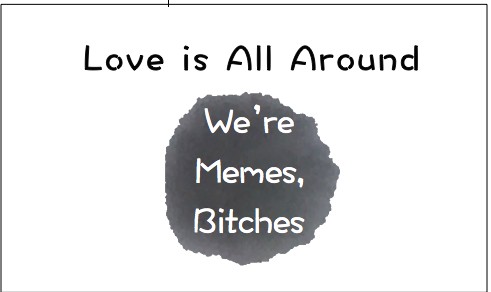
When I darkened it though, it looked a bit like a bullet hole. Which really is the opposite of the idea here—world peace through art.
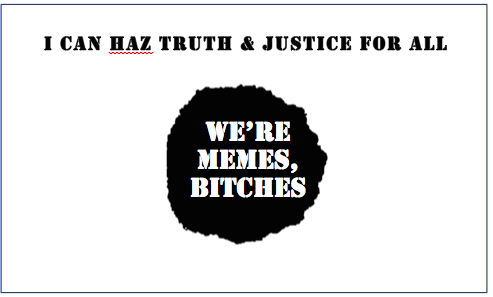
Plus that font doesn’t work. Neither does this one, although it’s more evocative of the old-timey font.
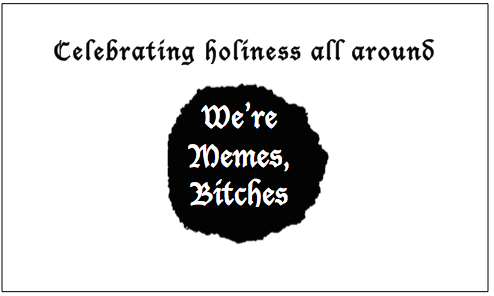
Plus the ISIS flag is actually done at a high level of professional work.My edges are too rough. I made these draft inversions using my camera phone and Microsoft Word.
To be honest, I really thought I could do this while living in a car with a napkin and a pencil. But I would like a big table and some oil paint now, please.
3. Making and improving the hate group follower algorithm.
Right now, anyone can manually identify who likes or follows a known ISIS-associated account on Facebook or Twitter. (I started making a very partial list of such accounts here.)
Manual might be best at the beginning. But we should have an algorithm for that and keep improving it constantly to keep up with changes in the information environment. Somebody has probably already done that, but making it from scratch will do if they don’t want to play.
4. Figuring out how to show-not-tell the pitch.
I suspect this means making something like a functioning draft website and troubleshooting it until it either works well enough to fund itself, or attracts start-up funding. I probably do need to secure funding for the project at some point, since my credit will run out eventually. But doing makes more sense than talking about doing. So if you know how I can do this better, tell me. I’m learning. And if you want to help me, tell me. I’ll help you learn.
One of the things I always struggled with as an artist was accepting myself. I think I thought art didn’t do anything useful. But now I understand stories and images to be the stuff of life. They can give us faith, hope, and love. Or they can take them away.